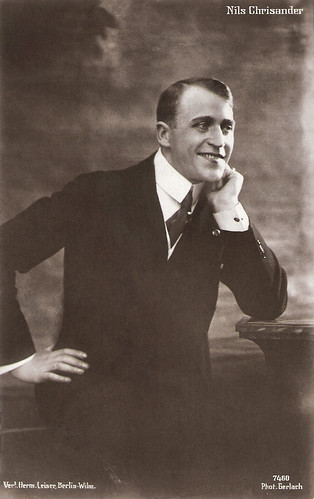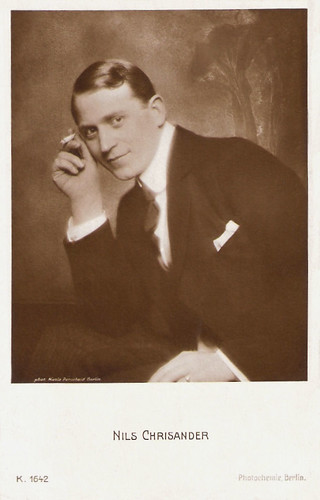
German postcard by NPG, no. 427. Photo: Alex Binder.

German postcard by Verlag Hermann Leiser, Berlin-Wilm., no. 7159.
The Phantom
Nils Chrisander or Nils Olaf Chrisander was born Waldemar Olaf Chrisander in Stockholm, Sweden, in 1884.
He probably made his film debut in the Danish production Et Gensyn/A Reunion (1914) for the Dania Biofilm Kompagni. His first German film was probably the silent drama Die Flammentänzerin/The Flame Dancer (Georg Jacoby, 1914) opposite Norwegian actress Aud Egede-Nissen. In the following years he played in the films Die Wellen schweigen/The Silent Waves (Rudolf Biebrach, 1915) with Henny Porten, and Um ein Weib/Because of a Woman (Carl Schönfeld, 1915) again opposite Aud Egede-Nissen.
As an actor, Chrisander is possibly best recalled for starring as Erik the Phantom in Das Phantom der Oper (Ernst Matray, 1916), the now-lost German adaptation of Gaston Leroux's novel The Phantom of the Opera. Matray's version is the first film adaptation of Leroux's 1909-1910 serialized novel. Aud Egede-Nissen co-starred as Christine and director Ernst Matray played The Persian.
That same year Chrisander also appeared in such Swedish silent films as Svärmor på vift/Mother-in-law on the Loose (Georg af Klercker, 1916), Fången på Karlstens fästning/Prisoner of Karl's Fortress (Georg af Klercker, 1916) and Revelj/Reveille (Georg af Klercker, 1917) with Mary Johnson.
Back in Germany, Chrisander appeared in Nicht lange täuschte mich das Glück/Happiness did not deceive me for long (Kurt Matull, 1917) opposite Olga Engl and the popular Polish film actress Pola Negri in her first role in a German production. He also played leading roles in the melodramas Die Vergangenheit rächt sich/The past takes revenge (Urban Gad, 1917) with Albert Paulig, Küsse, die man im Dunkeln stiehlt/Kisses that you steal in the Dark (Kurt Matull, 1918) with Pola Negri and Ernst Hofmann, and Die neue Daliah/The new Daliah (Urban Gad, 1918) featuring Maria Widal.

German postcard by Verlag Hermann Leiser, Berlin-Wilm., no. 7642. Photo: Gerlach.

German postcard by Verlag Hermann Leiser, Berlin-Wilm., no. 7460. Photo: Gerlach, Berlin.
The Golem
In 1919, Nils Chrisander started to direct silent films for the Deutsche Bioscop Gmbh. His first films were Olaf Bernadotte (1918) with Carl de Vogt, and Chrysanthéme/Chrysanthemum (1918) featuring Carola Toelle.
He co-directed the German silent film Alraune und der Golem/Alraune and the Golem with actor and director Paul Wegener.
J Zsalsberg at IMDb: “No prints of the film are known to have survived. Nor have any photographs, reviews, or even a decent credit listing. Poster artwork does exist, but German censorship/release records do not. Consequently, it is, indeed, possible that the film was never made at all, with the poster artwork having been created to advertise a "possible" production. In any event, the story is alleged to be based on the novel 'Isabella of Egypt' by Ludwig Achim von Arnim, in which the "Alraune" character is male and the golem is female!”
That year, he also directed Die weißen Rosen von Ravensberg/The white roses of Ravensberg (1919) with Uschi Elleot. After performing in the film serial Die Jagd nach dem Tode/The Hunt for the Death (Karl Gerhardt, 1920) opposite actress Lil Dagover, Nils Chrisander began his career in Germany as a director.
In total, he directed three films in Germany, before relocating to the United States where he directed two dramatic films: Fighting Love (1927), starring Jetta Goudal, Victor Varconi and Henry B. Walthall for Cecil B. DeMille Pictures, and that same year The Heart Thief (1927), starring Joseph Schildkraut and Lya De Putti. By 1930, he was living at S. Gramercy Place in Los Angeles, California. Nils Chrisander died in 1947 in Los Angeles (according to Wikipedia) or Skivarp, Sweden (according to IMDb). He was 63.

German postcard by Photochemie, Berlin, no. 1642. Photo: Nicola Perscheid, Berlin.

German postcard by Verlag Hermann Leiser, Berlin, no. 3125.
Sources: Wikipedia and IMDb.
This post was last updated on 25 September 2023.
No comments:
Post a Comment